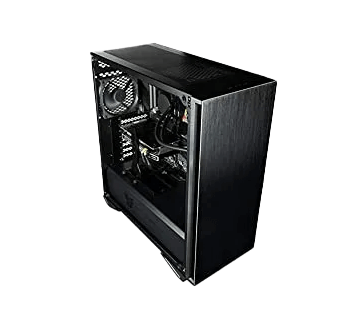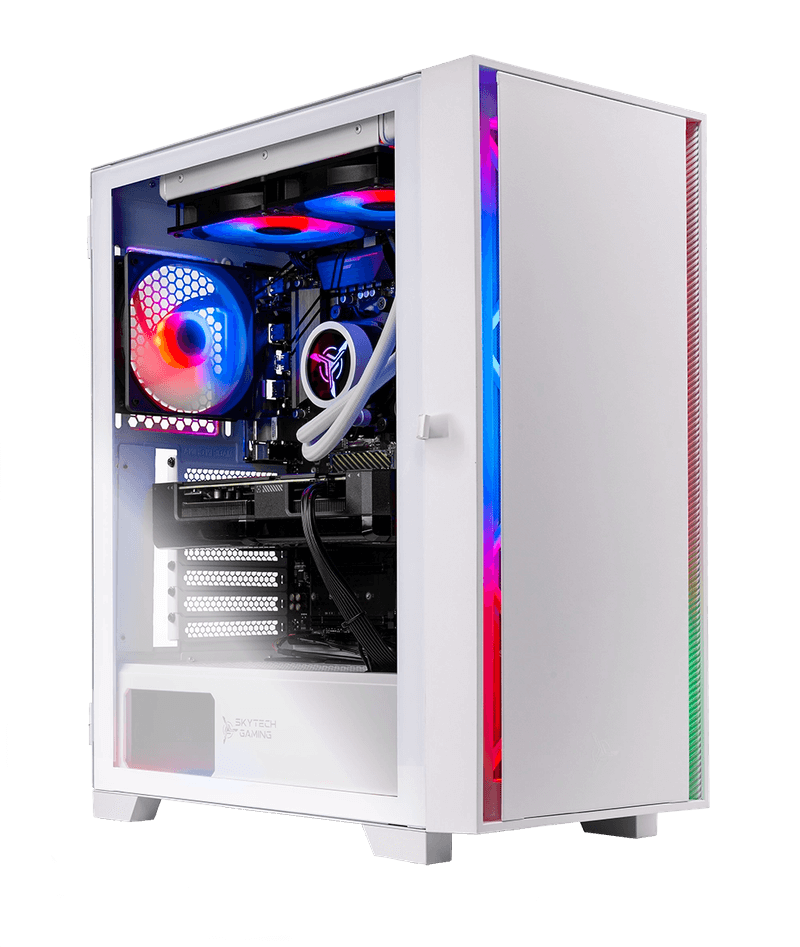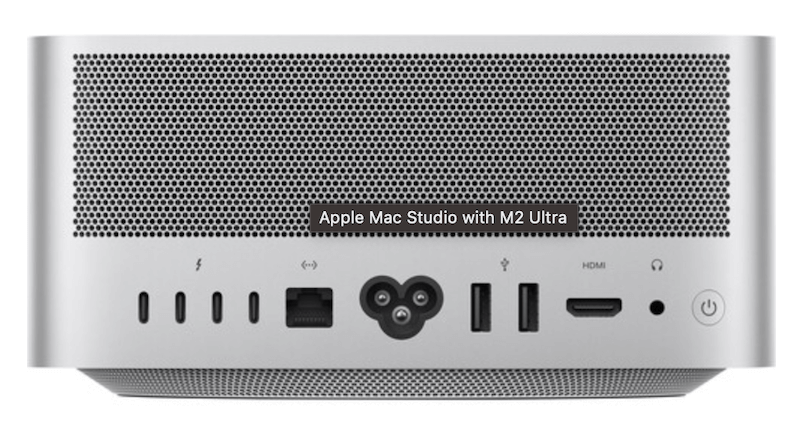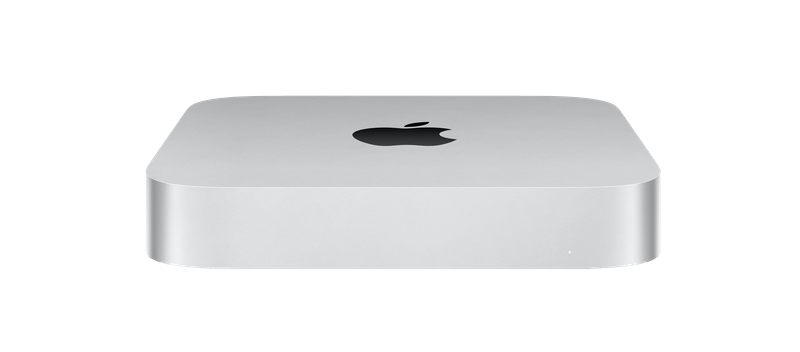As an Amazon Associate, I earn from qualifying purchases.
Most desktop computers available today are marketed towards offices or gamers, making it difficult to find the best desktop for Photoshop. It’s easy to get lost in an avalanche of tech specs that mean nothing unless you spend a lot of time with computer hardware, so how are you supposed to figure out which computers actually work well with Photoshop?
My name is Thomas Boldt, and I’ve personally built each of my desktop PCs over the last two decades – so I can completely understand why most people would prefer to buy a pre-built machine. While I enjoy the build process, there is a lot of appeal in just buying a machine that’s ready to run Photoshop instead of messing around with the hardware components.
I’ve used Photoshop for work and personal projects on many different computers over the past 20 years, from fruit-flavored iMacs with built-in CRT monitors to my current i9-12900K / 32GB / RTX 4090 custom build, and watching Photoshop evolve over that period to take advantage of new developments in computer hardware has given me a unique perspective.
In this post, I’ll take all the knowledge that I’ve gained through my fascination with computer hardware and distill it down into the elements that matter most for working in Photoshop. I’ll take you through all the tech jargon, how each hardware component affects your Photoshop workflow, and then select a few different desktop computers from different price and performance ranges – including a couple of desktops for Apple fans.
Table of Contents
Key Takeaways
- CPU and RAM are the biggest performance factors in most Photoshop workflows.
- Graphics cards are becoming increasingly important for AI-powered Photoshop tools.
- The best Windows desktop for Photoshop is the Empowered PC Sentinel Gaming Desktop, while the best value PC is the Skytech Shiva II.
- For Apple users, the Mac Studio (M2 Ultra Edition) is the best Mac desktop, while the M2 Pro Mac Mini provides a more affordable option.
Frequently Asked Questions
There’s a lot of information to take in when it comes to choosing computer hardware for Photoshop, so I’ve compiled a few of the most common questions that get asked by our readers. If you have a question that isn’t answered below, let me know in the comments below, and I’ll try to help.
Do you need a powerful computer for Photoshop?
Photoshop has very basic minimum hardware requirements: a multi-core CPU @ 2GHz, 8GB RAM, a GPU with 1.5 GB video memory, and 20 GB of hard drive space. However, if you actually try to do any serious editing work on high-resolution images using a computer that only meets those minimums, you’ll immediately run into slowdowns and delays as Photoshop struggles to complete your edits. A more powerful computer will complete your Photoshop editing tasks much, much faster.
Do I need 8GB or 16 GB RAM for Photoshop?
The base minimum requirement for Photoshop is 8 GB of RAM, but you will experience slowdowns and bottlenecks when trying to use any other apps at the same time or if you work on large, high-resolution files. 16 GB of RAM provides a much better editing experience, although 32 GB is even better if you can find the room in your budget.
Is it better to have more RAM or a faster processor for Photoshop?
This is a difficult question to answer without considering specific components. If you’ve got 8GB of RAM, it’s usually better to increase your RAM before worrying about your CPU. If you’ve got 16 GB of RAM already, then should probably upgrade your CPU to one that has at least six cores running at a high clock speed above 3 GHz. If you already have a fast processor with at least six cores, focus on upgrading your memory to at least 32 GB.
The Best Desktop Computers for Photoshop Reviewed
Now that you know what to look for in a desktop computer, let’s look at some pre-built machines that are perfect for use with Photoshop. I’ve selected one expensive and one value-focused desktop for both Windows and Mac, so you can find something that fits your budget.
Best Windows Desktop Computer for Photoshop: Empowered PC Sentinel

- OS: Windows 11 Home
CPU: Intel Core i9-13900KF (24 cores, 2.2GHz boosting to 5.4 GHz) - RAM: 32 GB DDR5, 5600MHz
- Storage: Intel 1 TB NVMe solid state drive, 3 TB HDD
- Graphics: Nvidia RTX 4070 Ti, 12GB dedicated video memory
Most top-tier Windows desktop computers available to consumers are gaming PCs covered in shifting RGB lighting panels, but doing color-sensitive editing work during a unicorn rave doesn’t sound like my idea of productive (no matter how fun it might be), so it’s nice to see a powerful machine that uses a stylish minimum of LED color accents.
The Intel Core i9 13900KF is the best consumer CPU currently on the market for Photoshop, and it can keep up with any workload. Thanks to 24 CPU cores split between 8 performance and 16 efficiency cores, all your computer’s normal background tasks will also be handled smoothly without slowing down your editing process.
32 GB of DDR5 RAM running at 5600MHz has enough speed and capacity for all your multitasking needs, allowing you to run Photoshop with multiple high-res files open, along with Lightroom, a web browser, and just about anything else you might want – all at once, without any stutters or delays.
A fast Intel NVMe solid-state drive provides a spacious terabyte of high-speed storage, while an accompanying 3 TB 7200 rpm mechanical hard drive offers long-term storage for files that don’t need fast access.
The final piece of the puzzle comes from the Nvidia RTX 4070 Ti graphics card, which features 12 GB of dedicated video memory. This is more than enough to run multiple 4K displays, and the 4070 Ti has an impressive amount of computing power for handling machine learning tasks like Firefly, Neural Filters, and Adobe’s new AI-powered noise removal tool in Camera Raw.
This machine can also be configured with a more powerful graphics card like the Nvidia RTX 4090 with 24 GB of dedicated video memory and up to 96 GB of main system RAM, but that really is mind-bogglingly excessive for most Photoshop workloads (and for most budgets).
The only thing I don’t like about this machine is the choice to include a large mechanical storage drive instead of a larger main or secondary solid-state drive. Even a SATA solid-state drive would be preferable to a mechanical drive, and they’re roughly comparable in price.
The TLDR Summary: Empowered PC Sentinel Gaming Desktop is the best for users who need a powerful machine that won’t completely empty their wallets.
Best Value Desktop Computer for Photoshop: Skytech Shiva II Gaming PC

- OS: Windows 11 Home
CPU: Intel Core i5-12600K (10 cores, 3.7GHz boosting to 4.9GHz) - RAM: 16 GB DDR4, 3200MHz
- Storage: 1 TB NVMe solid-state drive
- Graphics: Nvidia RTX 3060 Ti, 8GB dedicated video memory
If you don’t need the absolute best machine available, this desktop provides a solid foundation for serious editing work at a very attractive price point. The Core i5-12600K is roughly on par with the M2 Pro used in the value Mac pick below, and its 6 performance cores and 4 efficiency cores will make short work of most editing jobs.
16 GB of RAM is enough capacity for working on digital photos, even though it uses the older DDR4 standard, and the 1 TB NVMe solid-state drive will allow Photoshop to read and write to the scratch disk as fast as possible.
The real gem of this machine is the RTX 3060 Ti, with 8 GB of dedicated video memory. While it’s from the previous 3000 series, this is one of the most popular video cards on the market, thanks to its excellent balance of price and performance. It’s more than enough to run multiple 4K displays while exploring all the fancy new AI tools that Adobe is adding to Photoshop.
The only real drawback of this machine is the over-the-top RGB lighting that is integrated into almost every component – although I understand that there is probably someone somewhere who appreciates it. Fortunately, you can simply switch off the LED lighting system using the button near the top of the case when you need to do color-sensitive work.
The TLDR Summary: Skytech Shiva II Gaming PC is the best for anyone who wants to start exploring Photoshop with a limited budget.
Best Mac Desktop Computer for Photoshop: Mac Studio (M2 Ultra Edition)

- OS: macOS Ventura
- CPU: Apple Silicon M2 Ultra (24 cores, 3.5 GHz)
- RAM: 64 GB DDR5
- Storage: 1TB NVMe solid-state drive
- Graphics: 60-core GPU integrated with Apple Silicon, 32-core Neural Engine
In the past, I’ve recommended the Max version of the Mac Studio as the best Mac desktop for Photoshop because the added cost of the Ultra edition was hard to justify, but a lot has changed since then.
Adobe’s recent release of several AI-powered tools has put the Neural Engine front and center for Photoshop performance on a Mac, which means that the M2 Ultra is currently at the top of the Apple Silicon pile.
Unfortunately, the M2 Ultra edition isn’t available with 32GB of RAM, so you’re forced to choose a minimum of 64 GB. On the plus side, this means Photoshop will almost never need to use the scratch disk unless you’re working on enormous files, and you’ve also got a huge pool of memory available to the GPU and NPU for working with machine learning workloads.
The fast 1 TB NVMe solid-state drive included in this model is a great device with ample room for Photoshop and your working files, but I would expect a lot more storage space at this price point if it were a PC.
Hopefully, the Mac Studio will soon receive an update to the M3 series or even the rumored upcoming M3 Ultra, but Apple has yet to announce which new models are in the works.
The TLDR Summary: Mac Studio (M2 Ultra) is the best desktop Mac available for Photoshop without straying into the overly expensive world of the Mac Pro lineup.
Best Budget Mac Desktop Computer for Photoshop: Mac Mini (M2 Pro Edition)

- OS: macOS Ventura
CPU: Apple Silicon M2 Pro (10 cores, 3.5 GHz) - RAM: 16 GB DDR5
- Storage: 512 GB NVMe solid-state drive
- Graphics: 16-core GPU integrated with Apple Silicon, 16-core Neural Engine
While the idea of a budget Mac desktop might seem strange to some, the Mac Mini packs in some decent editing power thanks to the M2 Pro chip. It‘s roughly even in performance with the Intel i5-12600K CPU found in the Windows value pick and roughly even in pricing.
Paired with 16 GB of fast DDR5 RAM and a 512 GB NVMe solid-state drive, the Mac Mini is a great entry-level machine that is capable of doing actual Photoshop work. You might not get the best results possible when working with Adobe’s new AI tools, but
As a surprise to no one, there is one area where the Mac Mini really shines: the form factor. The entire computer is tiny and can be easily carried in one hand, which is even more impressive considering the size of the PCs I’ve selected.
The Mac Mini also draws a minuscule amount of power, just 185 watts compared to the 600-watt maximum on the PC value pick, which can be an extra little advantage when you have to run your computer for long hours.
The TLDR Summary: Mac Mini (M2 Pro) is a great entry-level desktop Mac for editors who want to explore Photoshop with a capable and affordable machine.
How to Choose a Desktop Computer for Photoshop
A computer contains a surprising number of different components that each play a role in how your system functions and how well it can handle a Photoshop editing project. Let’s take a closer look at the key components and how they impact Photoshop – or how they don’t.
Operating System
The first thing you need to decide when choosing a desktop computer for Photoshop is whether you want to use a Windows PC or a Mac. Macs used to dominate the creative world, but when it comes to Photoshop editing, there isn’t much difference between the two operating systems anymore. Windows desktops tend to be more affordable than comparable Mac desktops, but beyond that, it really comes down to personal preference.
CPU
Photoshop’s tech specs require a multi-core CPU running at a minimum clock speed of 2 GHz, although you’d have a hard time finding a desktop machine for sale in the last decade that couldn’t meet that requirement.
CPU speeds are a major factor in how fast Photoshop handles your edits. You should aim for a minimum CPU clock speed of 3GHz and preferably closer to 5GHz, because the faster your processor is, the faster your edits can be completed.
Additionally, CPUs with higher core counts run Photoshop faster, up until you reach six cores. Beyond that point, the benefit of each added core is reduced, according to Adobe’s own post on the subject. Some tools and processes will use multiple cores more effectively than others.
That said, most editors aren’t just running Photoshop and nothing else, despite what Adobe seems to believe. If you want to maximize your productivity, get a CPU with a high core count, and you’ll have six cores available for Photoshop to get great performance while the additional cores can run the rest of your apps and background processes smoothly without causing any slowdowns in Photoshop.
RAM
Random Access Memory (RAM) acts as your computer’s short-term memory for running your operating system, your apps, and working on documents. The more RAM you have, the more high-resolution files you can edit at once while keeping other apps running smoothly in the background.
Photoshop requires a minimum of 8GB of RAM to run, but I recommend a minimum of 16GB if you’re serious about doing real work in Photoshop so that you can run multiple apps effectively. If your budget allows for it, a desktop with 32GB of RAM is a much better option, but beyond this point, there’s a diminishing return for your dollar.
You can find computers with 64GB of RAM or more, but they’re typically used for high-resolution video editing and not for Photoshop work, so unless you’re planning to edit lots of very large files at once, 64GB is more than you need.
In addition to capacity, it’s important to note the specification your RAM uses. The best option currently available for main system memory is DDR5, which has replaced the slower DDR4 standard. Within each standard, there is also a speed rating for the memory in MHz, with faster speeds being preferable.
Storage Drive
The humble storage drive was often the most overlooked aspect of a computer’s performance until the solid-state drive revolution really kicked off. As you might guess from the name, solid-state drives have no moving parts, which allows them to read and write data much faster than older mechanical drives.
This was a huge boost for all Photoshop editors since Photoshop relies heavily on your storage drive’s read and write speeds for a feature known as the ‘scratch disk.’ The scratch disk is a temporary storage space used by Photoshop to hold all the aspects of your open files that don’t fit into your main system memory, such as history states and off-screen image tiles. Reading and writing data at a faster rate can dramatically improve your Photoshop scratch disk performance, and it will also help to speed up the loading and saving of large files.
The minimum hardware requirements state that Photoshop needs at least 20 GB of space to install and run, but Adobe recommends having at least 50 GB of space available on a fast SSD.
The best desktop computers for Photoshop will have at least 512 GB of storage space on an NVMe solid-state drive, so you have plenty of room to store all your apps and working files. In a perfect machine, this drive will be 1 TB or larger and use the PCIe 4.0 connection standard, but even a PCIe 3.0 NVMe drive is faster than a SATA SSD or a mechanical hard drive.
Graphics Card
Most Photoshop workloads don’t tax the graphics processing unit (GPU) too heavily, so in the past, graphics cards weren’t a big factor when choosing the best computer for Photoshop. Photoshop has a very low minimum GPU requirement of 1.5 GB of dedicated video memory, although Adobe recommends a card with at least 4 GB for use with a high-resolution display.
However, there are a growing number of Photoshop tools that rely on machine learning algorithms that GPUs excel at, including Adobe’s new Denoise algorithm in Camera Raw, as well as the growing collection of Neural Filters. When you combine that with the recent integration of Firefly, Adobe’s generative AI, it’s time to start taking the role of graphics cards more seriously.
Apple is in a bit of an unusual position due to these recent changes since only the Mac Pro can be configured with a discrete GPU, while other Macs use Apple Silicon chips with an integrated GPU. The comparison gets interesting – and more confusing – when you consider that they also contain Apple’s proprietary Neural Processing Unit (NPU), designed specifically for accelerating machine learning AI tasks.
Nvidia makes the best graphics cards currently available, but their top-tier cards are excessive for most Photoshop workflows. The Nvidia RTX 4090, with 24 GB of dedicated video memory, is the best graphics card in the world at the moment, but the card alone costs more than some entire desktop systems, and Photoshop doesn’t really push it to the limits of its abilities the way 3D and video rendering workflows can.
Since these Photoshop tools are so new, there’s very little reliable benchmarking data available to pinpoint exactly how much of a return you’ll get for your dollar. Still, it’s safe to say that graphics cards are now much more important to Photoshop than they used to be.
A Final Word
The world of computer hardware is extremely fast-moving, so many people are tempted to wait for the next big upgrade to be released – but there’s always another ‘next big thing’ just around the corner. Save yourself from the stress of wondering and focus on what’s available right now, so you can get back to editing.
Enjoy your new selection!
About Thomas Boldt
Robert Roa
I’m 77 years old and I’ve been using Photoshop for about 15 years or more. My current computer has Adobe Photoshop and Adobe Illustrator which are updated every year. The purpose of leaving this comment with you is to compliment your ability to clearly state what Photoshop demands from a desktop computer
I’m at a point now to move on from my current 12 year old outdated desktop computer to purchase those computers that are compatible with Photoshop.
Thank you very much. You’ve made my search so much clearer!
June
Hey Robert, glad you find our article helpful! Cheers!
Shashi
Very informative. Can you please take the trouble of listing down the specs to help me make a choice. I do not do video editing.
Thomas Boldt
Hi Shashi, you can find the most important specs for each of the machines listed just below the titles. I hope that helps!
Leila
Fantastic article that really takes the time to explain things in layman’s terms.
Out of interest, for a complete newbie to PCs currently upgrading from a mac, is it possible to upgrade the RAM on the Empowered PC Sentinel you recommend? I work on extremely large files at times and may need more than 32Gb but I’m not 100% sure.
Thomas Boldt
Hi Leila, you’re very welcome! One of the best things about switching from a Mac to a PC is how flexible PCs can be when it comes to upgrading.
On recent Mac models, Apple has been using a technique it calls ‘Unified Memory,’ which is actually soldered onto the motherboard and cannot be changed or removed – but on a PC, including the Empowered PC Sentinel mentioned above, you can add and change your memory as long as it’s compatible with the motherboard. You have to know a bit more about the tech, but it’s nice to have the flexibility.
Also, adding PC memory is much, much cheaper than adding a comparable amount of Apple memory!